Message 3554, Jul 22, 2001
Hi Downwind28, The photograph of the HGU-2/P appears to be a late issue (not early)
version; indicator is the blue plastic visor slider slot sheathing and blue flat lock-knob
(although this could have been added to a shell, certainly). The blue visor slider slot
sheath was a late issue innovation to help the visor to be moved more easily. The Hardman
receiver kit is typical on helmets of this time-frame (early to mid 60s) and a Hardman
mask shell and suspension kit is also not too unusual for this specific helmet. Due to the
fact that the visor is down, shielding interior details from our view, it isn't possible
to be more specific than that. Sometimes Navy style (APH type) interior fitting pads were
used by USAF pilots, when they could obtain them, since they were more comfortable than
the somewhat cheap foam sizing pad sets that HGU-2/P helmets were provided with. A 1955
dated MS22001 mask could have been used, but it was more typical by that time to find
HGU-2/P helmets in use with MBU-5/P masks (and Sierra type receivers) by the 66-67 period.
The Hardman kit and MS22001 type suspension used with an MS22001 mask were far more common
on late issue P-series helmets (P-4B) than on HGU-2/P types, but were also used on early
HGU-2/P types after removal of the issue leather tab suspension items. Perhaps this set
was used by someone in flight test (who preferred this set-up), or the mask and suspension
was added to the helmet by previous owner? Or was this a foreign application helmet (i.e.
used in Europe by European NATO member nation)? The mask's com cord looks to be authentic
USAF configuration for this period and my guess is that this mask and helmet was used
together as a set by someone. The cover photo of the soft-bound edition of Bill
Bridgeman's (well known early jet age American flight test pilot) biography shows an
identical helmet and mask set-up in use together, photo dated mid-60s. Flight test pilots
had a bit more personal influence over what they wore in terms of helmet and mask
combinations than did regular USAF aircrew (who were more tightly bound by TO
directives--with small variances within the well-known limits).
Thanks for sharing the photos with us.
Cheers, DocBoink
Message 3548, Jul 22, 2001
I have two helmets which I cannot clearly "type designate". Perhaps someone
can help me here (pics attached).
The first one is an HGU2-type setup with hardman receivers and a 55 dated MS22001 - could
this be a very early HGU2A helmet? Everything looks original except the leather pads
inside - they seem to be from different origins and the front one is missing - bummer.
Thanks and regards,
downwind28
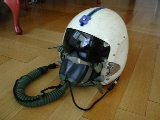
Message 3324, Jul 1, 2001
I sent several images of the original helmet, with the visor decals being measured by
Colonel Chandler, along with only one image of the restored helmet. The other images of
the restored helmet (that I forgot to attach before) are attached to this post.
Cheers, DocBoink



Message 2562, May 28, 2001
Here's another pic of that helmet art.
Greets,
Message 2561, May 28, 2001
By the way, that's great helmet art!
Cheers, DocBoink
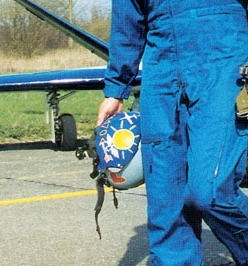
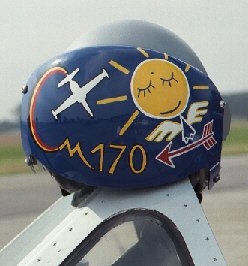 Message 2556, May 28, 2001
Message 2556, May 28, 2001
Aircraft is a Fouga Magister. Helmet is a HGU-26/p, pilot is Jean-Charles
Kotwicz-Herniczek who flew the solo display until last year.
Greets,
Message 2212, May 9, 2001
Hello Gato, The earliest version must be the one with metal strip reinforcements and a
blue push-button lock knob shown on the HGU-2/P that DocBoink has on his website. If you
are planning to use a bayonet attachment system for your O2 mask then perhaps it would be
more appropriate to use a visor housing with a blue screw-action four-lobe lock knob like
the one shown on the Check 6 Aviation website.
I have a single visor housing but from a much later date. It is a mid-1980s HGU-26/P
single visor made entirely out of plastic with a white four-lobe screw-action lock knob. I
am not sure about its size but I will check it if you are interested.
Cheers, Bluelight
Message 2210, May 9, 2001
Hello Bluelight, Yes, I would like the original HGU-2 cover, if possible and not
astronomically priced. Is it the one with metal rails in the center? What sort of control
knob did it use? And Darkside, if you have a "righty" clear large visor, hang on
to it for a little while. If the one from HUD doesn't show up, I'll be needing yours. Or,
I could take yours and repay you with his, when his shows up. Of course, I can pay you or
trade something. We shall talk some more if you have the large visor.
Thanks to both Bluelight and Darkside, and HUD too, Gato over
Message 2208, May 9, 2001
Darkside and Gato, According to my HGU-26/P T.O. the same visor sizes are used for large
and X-large helmet shells. I know from RDAF sources that it applies both to the HGU-26/P
single visor and double visor versions, and it also applies to the HGU-2A/P-D three-piece
ramshorn version. Since the HGU-2/P is based on the same helmet shell (the one that later
became the HGU-22/P) I would be very surprised if it did not apply to that one as well.
And I take it, Gato, that you are looking for the original HGU-2/P visor housing rather
than the later HGU-2A/P or HGU-26/P single visor?
Cheers, Bluelight
Message 2120, May 6, 2001
Perhaps I mentioned the fact that I managed to pick up an HGU-2/P that was previously the
personal bone dome of by Lt. General Thomas K. McGehee? The helmet was worn by this
interesting former commander of NORAD and Vice Commander of ADC back in the late 60s and
has the squadron markings of the 326th FIS that flew F102s out of Richards-Gebaur AFB in
Missouri, while the General was Base Commander there. He kept his hours current with that
particular squadron and their personal equipment people kept this helmet at the ready for
him, when he flew. I have managed to precisely date this helmet to 1961, which is the only
year he could have been flying with the 326th (he arrived the previous year and it
disbanded the next year--convenient chronological 'bracketing', if you ask me!). The black
wolves on the visor cover are the 326th FIS insignia, as they were known as "The Sky
Wolves". I have attached a few images of the helmet and the 326th FIS's emblem, in
case anyone is interested in this. The helmet was fitted with Hardman kit receivers and
after a bit of cleaning up, this specimen proved to be quite a nice one. There is a very
interesting USAF biography on Lt. General McGehee on the USAF website, by the way. He
retired in the early 70s, after a long and fascinating Air Force career, and is now living
in Florida.
Also acquired another early HGU-2/P helmet formerly worn by a pilot in my old F106
squadron (5th FIS of MAFB, ND)--the 5th FIS actually was not my own squadron, but I was an
"adoptee" of the unit, as an aeromedical specialist who was always getting
underfoot, bugging the pilots, and creating a general nuisance of myself as a henchman of
the dreaded Flight Surgeon. The helmet is white, with a dark blue painted visor cover,
upon which are the 5th FIS squadron emblem (dexter side of helmet) and a stylised emblem
of the F106 "Six" (on the sinister side). I'll have some pictures of it (of the
whole helmet) in future, if anyone is interested in seeing them. The other attached scan
shows the visor cover colors and emblems for 5th FIS in 1966 (when this helmet was worn).
Cheers, DocBoink

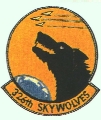
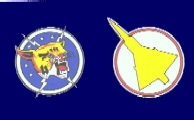
Message 1921, Fri Apr 20, 2001
My helmet is an original combination. The mask was used together with the helmet by an
Phantom/Tornado instructor named Becke. Anybody got a napestrap or s-hook that he's
willing to sell? The s-hook was missing and the leather nape strap is rotten brobably from
the sweat or something.
greets,
Message 1916, Apr 20, 2001
Timcat,
What you have is an HGU-26/P & German MBU-5/P. The electronic connectors look to be
the standard NATO two pin.
Darkside
-----Original Message-----
Thanks for your answers! Does anybody know more about that plug? I have another
question. I paid $396 for my helmet with MBU 5/P oxygen mask is this a good price or to
much? you can see a picture at http://home.planetinternet.be/~soetim/helm.jpg
greets,
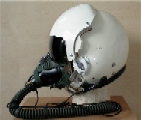
Message 1621:
Hi Steve, Thank you for your elaborate and very useful answer. A couple of additional
points based on your comments:
> 4- I have no cancellation of the mil-spec for the HGU-2A/P so I can't say
> exactly when it was "Obsolete". I have one Hint: a TO 14P3-4-522 for
> modification to the HGU-2A/P visor housing to increas visibility was
> rescinded May 1, 1969. The only reason to rescind would be if the helmet was
> declared obsolete (maybe)...
What if the information was included in another T.O.? The T.O.14P3-4-112 on the HGU-26/P,
which is dated 1 May 1970 originally, includes information on how to modify the single
visor housing by trimming the lower edge to a "gull wing" profile. If -522 also
describes such kind of modification this could be a reason for rescinding it. Also, since
the HGU-2A/P helmet is mentioned in the -112 it should not be obsolete by 1 May 1970 at
least.
> 5- The HGU-26/P request for nomenclature is dated Jan 14, 1970 and is based
> on the HGU-22/P Helmet Shell Subassembly (contradicts the HGU-22/P type
> designation sheet). In order to procure an HGU-26/P a mil-spec would have to
> be issued and a Qualified products list issued. But since the HGU-22/P and
> all the components were already stanadardized, many HGU-22/P labeled helmets
> could enter service in HGU-26/P configuration. And since the USAF did not
> re-designate each configuration, the HGU-26/P can use a bunch of items and
> still be an HGU-26/P. Gentex manufactured an HGU-26/P but referred to the
> HGU-22/P mil specs indicating that there may not have been a separate spec
> for the helmet.
The timing of the request for nomenclature at least fits in nicely with the original date
of T.O. 14P3-4-112. I guess the T.O. originally would have been titled something like
"Flying Helmet Assembly Type HGU-2A/P and HGU-26/P" but in my version it only
mentions HGU-26/P on the title page because it reflects the latest time of update (15
February 1995). Anybody has an earlier version of T.O.14P3-4-112?
Do you know if any of the helmet types based on what became the HGU-22/P shell were
equipped with a strap suspension assembly (like the one used in SPH-3B and others) instead
of the fitting pad system? None of the helmets in the Wise & Breuninger book seem to
have it (no screws on the outside of the helmet shell). I do not have a scanner at home
(yet) but when I pass one I will post some pictures of an HGU-2A/P-D helmet made by Gentex
to Danish Air Force specifications with strap suspension assembly and three-piece visor
assembly. Cheers, Bluelight.
Message 1620:
Right, Steve. I was told by Danish Air Force life support technicians that in connection
with the HGU-26/P to HGU-55/P conversion they cut back the edges of the HGU-22/P shell
around the face in order to fit the Sierra Snap-On edgeroll and to improve the pilot's
field of vision. It might not fully have met the HGU-55/P's field of vision but it was
improved over the HGU-26/P. Cheers, Bluelight
Message 1618:
Bluelight, As you can clearly see, the reference materials are not completely clear and in
some cases, actually contain errors. I Can add a couple of specifics but not all you
asked.
1- The HGU-2/P nomenclature was assigned on 15 August 1957. The HGU-2/P and APH-5 were
based on the same helmet with the USAF standardizing their's as the HGU-2/P, the US Navy
and US Army had the APH-5 and APH-5A respectively. Source: Gentex Technical Report.
2- The HGU-2A/P nomenclature (USAF way of indicating an upgrade to the HGU-2/P is with the
"A") was assigned 2 Nov 1960 as the result of design changes documented by both
SAC (Form 81 16 NOV 1959 and TAC (Form 81 28 Oct 1959). So the HGU-2/P was upgraded to the
HGU-2A/P at this time. Doesn't mean it got into the field at this point, only that the
mods had been identified and type designation assigned. Source: USAF Type Designation
Sheet for the HGU-2A/P.
3- HGU-22/P "Helmet shell, Flying" Type designation assigned 26 APR 68. This is
the same shell used on the HGU-2A/P. The "purpose" as stated in the request for
nomenclature was to allow the USAF to order the shell and some components that could then
be upgraded or modified to mission requirements in the fields. Mil spec MIL-H-83147 is
originally dated 24 Jun 1968. QPL issued 19 Mar 1969 (Gentex and Sierra only 2
manufacturers at this time). So no one could have sold an HGU-22/P to the USAF prior to
this date.
4- I have no cancellation of the mil-spec for the HGU-2A/P so I can't say exactly when it
was "Obsolete". I have one Hint: a TO 14P3-4-522 for modification to the
HGU-2A/P visor housing to increas visibility was rescinded May 1, 1969. The only reason to
rescind would be if the helmet was declared obsolete (maybe)...
5- The HGU-26/P request for nomenclature is dated Jan 14, 1970 and is based on the
HGU-22/P Helmet Shell Subassembly (contradicts the HGU-22/P type designation sheet). In
order to procure an HGU-26/P a mil-spec would have to be issued and a Qualified products
list issued. But since the HGU-22/P and all the components were already stanadardized,
many HGU-22/P labeled helmets could enter service in HGU-26/P configuration. And since the
USAF did not re-designate each configuration, the HGU-26/P can use a bunch of items and
still be an HGU-26/P. Gentex manufactured an HGU-26/P but referred to the HGU-22/P mil
specs indicating that there may not have been a separate spec for the helmet.
6- The HGU-55/P has most of the holes etc that the HGU-22/P has only the -55 shell
(Actually the PRK-37/P was used for the HGU-48/P prototype which became the HGU-55/P). The
point: all the holes etc on the HGU-22/P shell would be the same as the -55 and modifiying
the -26 to look like a --55 would be no problem. Except the -26 would not have the
visibility of a true -55. TOs indicate that USAF life support could refurbish nearly every
piece on the -26 and -55 while Navy parariggers do not re-work edgerolls or repair paint.
So a USAF life support tech would have all the equipment and supplies and know-how to make
an HGU-26/P look like an HGU-55/P.
Hope this helps? Cheers all, Steve Norris
Message 1615:
Hi HUD, DocBoink, Rich Mays, Steve Norris et al,
After having read, heard and contributed to the HGU-2, HGU-22 and HGU-26 discussion on
flightgear over a lenghty period of time, I have now studied my newly acquired HGU-26/P
technical order (T.O.14P3-4-112) in detail. The date of the T.O. is 1 May 1970, Change 63
15 February 1995. Below I will refer to this T.O. only as "the T.O.".
The following is an elaboration on my earlier comments to HUD on the HGU-22/P vs. HGU-26/P
designations. It is not meant as criticism of any of the great work done by others. Please
accept my comments as an honest attempt to shed some more light on this topic. I will be
using quotes from the T.O. in order to (try to) clarify the difference between the three
designations HGU-22/P, Quarter Shell Assembly and HGU-26/P.
In the T.O. the HGU-22/P is constantly referred to as "the HGU-22/P helmet
shell". Furthermore it says "The assembled components comprising a HGU-22/P
helmet shell are shown in figure 2-1". The mentioned figure "HGU-22/P Helmet
Shell (Cross Section View)", which is from the original T.O. dated 1 May 1970 and not
changed since, shows an outer shell, energy absorbing liner, front edge pad, edge beading,
and visor attachment hardware (flange nut and lock washer). Furthermore, holes for nape
strap, headset cord, lacing cords, and chin strap are identified, but chin and nape straps
are not shown. In the Section describing the "Helmet Shell Sub-Assembly" it
is,however, mentioned that "a chin and nape strap are provided with the HGU-22/P
helmet shell".
Issues are confused a bit in Section VII "Visor Assemblies". It says about the
single lens assembly that it is interchangeable with "the assembly supplied as
standard equipment on the type HGU-22/P helmet" (SIC!). Suddenly the HGU-22/P
designation includes a visor assembly, but that does not tie in with the information given
before or later. Three types of dual visor assemblies are described. The Sierra Part. No.
561-434 and -435 assemblies (popularly known as the one-piece ramshorn assembly), the
Gentex Part No.70D2190 and 70D2191 (popularly known as three-piece ramshorn assembly), and
the side-actuated dual visor assembly, Sierra Part No. 561-630 (also known as the PRU-36/P
assembly, but the two designations are not listed next to each other in the T.O.). No
helmet designations are mentioned in connection with the two former assemblies, but the
latter is specifically mentioned in connection with the HGU-26/P helmet. The two former
visor assemblies have no military stock numbers but are listed as "commercially
available".
In connection with maintenance it is mentioned that helmet shells damaged beyond repair
should be condemned and replaced with a new "HGU-22/P helmet shell subassembly"
and then installed the required accessory components. A table is providing a listing of
components "which, when assembled, will comprise a Type HGU-26/P helmet". The
table in question includes the HGU-22/P shell, single visor assembly, 561-630 dual visor
assembly, earcups, pads, nape and chin straps, edge beading, visor lenses, and the
HGU-17/P liner. Please note that the oxygen mask recievers or boom microphone are not
mentioned. To judge from the change dates this information has most likely been in force
from 1 May 1980, but definitely from 15 December 1983. Another table dated September 1979
gives the only mention of the "Quarter Helmet Assembly" and it is specified that
it is comprised of a bare HGU-22/P helmet shell with chin and nape straps and either
single or dual visor assembly completely installed.
Of further interest are the following quotes: "The basic helmet shell sizing system
has been in use since adoption of the HGU-2/P helmet series (1959)", i.e. the HGU-2/P
was introduced in 1959. A sub-section is provided on the modification of the HGU-26/P
helmet to HGU-55/P lightweight configuration.
My conclusions and assumptions from all of the above are the following:
1) HGU-2/P was introduced in 1959.
2) HGU-22/P is not a helmet as such but only the designation of the helmet shell, probably
with chin and nape strap (Steve Norris supports the view that they are included in his
message 1323 on flightgear)
3) The quarter shell assembly is an HGU-22/P with chin and nape straps and either single
or dual visor assembly completely installed.
4) HGU-26/P is a complete helmet consisting of an HGU-22/P with chin and nape straps and
either single or dual visor assembly completely installed, with communications gear and
pads/liner, but not necessarily with oxygen mask recievers or boom microphone.
5) Helmets marked HGU-22/P were probably acquired from the factory either as bare shells
or quarter shell assemblies and completed by user air forces. Helmets marked HGU-26/P were
probably acquired from the factory fully furnished, except for oxygen mask recievers
and/or boom microphones.
6) The HGU-2/P and HGU-2A/P designations disappeared some time before 1980. Single visor
helmets based on the HGU-22/P shell and manufactured after 1980 are HGU-26/P rather than
HGU-2A/P. This contradicts the views expressed in Rich Mays' article on the HGU-2A/P,
-22/P and -26/P helmet on the Flightgear Online website, where single visor helmets are
mentioned as HGU-2A/P.
7) and perhaps a bit off the mark; an HGU-26/P can be modified to HGU-55/P even if the
helmet shells are not the same.
The picture about the -2, -22, and -26 is still not fully clear, though. We know from
Steve Norris (message 1323) that the HGU-22/P designation was assigned in April 1968, but
I still miss the answers to the following questions:
a) When did the HGU-2/P helmet go out of production?
b) When was the HGU-2A/P introduced?
c) When was the HGU-26/P introduced?
d) When did the HGU-2A/P helmet go out of production?
Cheers, Bluelight
Message 1614:
Hi Rich and others, Was not aware of that, so that is why a lot of these shells have an
extra snap. Any body have a picture of such a setup? Bye HUD
Message 1612:
The strange snap is actually for the G-635 nuclear flash goggles- they are really M-1944
with gold lenses. It is a different size than the snap on the lightweight visor. Rich
Message 1611:
Bingo! That is very likely the answer, as these M-44 type rubber framed goggles with the
gold anti-nuclear flash lenses are intended to be fitted exactly as you remarked. Although
I have no TO in front of me to prove the contention, I'd almost be willing to bet on this
explanation! Good show (and good deductive logic, supplemented by the cited KC-135 crew
member reference)! Cheers, DocBoink
Message 1610:
Hello all, I understand the intended use for the second pair of male snaps present on some
HGU-2 and 26 helmet shells is for the flash goggles based on the rubber framed M 1944 or
similar type that have the gold coated lens. The kit allows them to be snapped to the
shell, or used with a small length of rubber strap w/male snaps to form a standard head
band. I purchased a helmet from a gentleman who was issued it as a KC-135 crewmember while
with SAC in the late 70's that had these extra snaps. Any other thoughts ? Regards, Steve
V.
Message 1609:
Hi HUD Not sure. That's possible. I DID wonder what that snap was for. It did come as
shown, just rather tatty and bad tape. Cheers DC5
Message 1607:
Hi DC5,
> Just thought I'd pipe in and toss in a couple pics of a helmet (HGU-22
> (26??)) I restored and re-taped. What a not-fun job, but I think it turned
> out OK. Always get extra tape!
Is this a helmet formerly used with some sort of egress or other drill? I have recieved
some of these helmet shells that also had the extra snap fastener on the side as yours. I
was told these were former drill helmets where an HGU-55/P type visor was attached to. Bye
HUD (And yes, nice tape job!!)
Message 1604:
HUD, A correction from my last message [Message 1598], which was written in my
office without the helmet in front of me. My factory-fresh HGU-26/P DOES have
communications but NOT O2-recievers. Interesting though that the single visor or dual
visor no longer is a way of distinguishing between HGU-2A/P and HGU-26/P. Probably that
only applies to helmets produced after a certain times. When is anybody's guess until more
light is shed on this seemingly never ending topic. Cheers, Bluelight
Message 1599:
Just thought I'd pipe in and toss in a couple pics of a helmet (HGU-22 (26??)) I restored
and re-taped. What a not-fun job, but I think it turned out OK. Always get extra tape!
Dave Clark 5


Message 1598:
[Answer to message 1588] HUD, From my recently acquired T.O. on the HGU-26/P
helmet and from information gathered during my Danish Air Force round trip last week I
venture the following guess on the different nomenclatures: - HGU-22/P is the bare helmet
shell. - Quarter Helmet Assembly is an HGU-22/P shell with chin and nape straps and either
a single or double visor assembly completely installed - HGU-26/P is a Quarter Helmet
Assembly with the necessary fitting pads. There is some evidence that the communications
gear and O2 receivers are not necessarily delivered with an HGU-26/P unless specifically
requested by the customer. I have a factory-new HGU-26/P single visor in its original box
from GENTEX with no comms gear or O2 receivers installed. The labels attached to the
helmets we see on eBay and elsewhere most probably tell us something about the way the
helmet was originally ordered from GENTEX and not so much about the final configuration of
that helmet. Cheers, Bluelight
Message 1596:
Hi Mauro, Your HGU-2 looks nice as this, but if you want to replace the tape job you must
looking for a set of camouflage pattern vinile sheets issued by the USAF for this
pourpose. This tape sets come in form of 4 adhesive sheets of about 40 x 40 cm that you
must cut out in stripes for do the job. Sometimes these sheets may be seen on Ebay for
sale of about $30.00 - $40-00 . Ask to flightgear Ebay sellers for knowing availability.
Hope this helps Regards Tapky
Message 1595:
Hi Alex, It's funny speaking English between two Italian guys? However, the helmet was
very bad damaged and all covered by oil. I had no choises. I sandpapered the mask
receivers and airbrushed them with olive drab paint using enamel cover (great job!). All
screws were polished (giusto? lucidate) with a special foam used for aluminium windows.
Now the helmet is factory white. Check 6 Aviation will send to me 4 meters only of the
tape I'm looking for. Thank you very much for your kind attention. See you Maurizio
Message 1594:
Ciao mauri, Why do you want to change the tape job ? The helmet looks great that way and
it still retains it authenticity. In my humble opinion do not re-tape it. Just leave it as
it is. Ciao Moonbeam (Alex, Monza)
Message 1592:
That's me again! Herewith enclosed you can find another view of my flight helmet. Please
note that no one label/mark indicating helmet type, date of manufacturing, contract is
present on it. The low section of the visor cover is custom-cutted allowing large eyes
view so the under cover markings are not visible... Bye Maurizio
Message 1591:
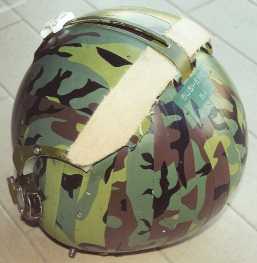
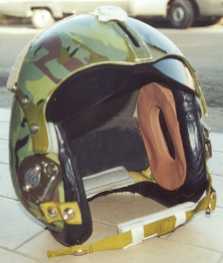 Herewith attached you can find a picture of my HGU 2 or 26
(maybe...suggestions are always well accepted!) taped with camo tape. The camo tape was
bad damaged (the photo is not showing the real damage) and oil dirty, so I was obliged to
remove it. After a general cleaning and restoration, I need to re-tape the helmet with the
same kind of tape/pattern. Which tape is that? Do you know the producer? Is still in
commerce? Is there a kind person that could buy it for me? After several inquiries to
hunting and fishing shops and military suppliers, all replies were negative... :( Here we
go with the second question: on the helmet there was the Dymo printed pilot callsign label
"BUSHEME 64". What does it means in English? Is there a web site where I could
find the real name of the pilot, the age of the helmet, the airplane, and so on? I know
that it's hard to find, but.... Many thanx in advance for your collaboration and patient.
Bye Maurizio
Herewith attached you can find a picture of my HGU 2 or 26
(maybe...suggestions are always well accepted!) taped with camo tape. The camo tape was
bad damaged (the photo is not showing the real damage) and oil dirty, so I was obliged to
remove it. After a general cleaning and restoration, I need to re-tape the helmet with the
same kind of tape/pattern. Which tape is that? Do you know the producer? Is still in
commerce? Is there a kind person that could buy it for me? After several inquiries to
hunting and fishing shops and military suppliers, all replies were negative... :( Here we
go with the second question: on the helmet there was the Dymo printed pilot callsign label
"BUSHEME 64". What does it means in English? Is there a web site where I could
find the real name of the pilot, the age of the helmet, the airplane, and so on? I know
that it's hard to find, but.... Many thanx in advance for your collaboration and patient.
Bye Maurizio
Message 1588:
Hi All, Any of you seen this?[eBay auction link] Here is somebody probably mixing
up information.We have had our share of discussions concerning HGU-22/P quarter assy's.
All the shells I have/had of 22/p all have the 22/P designation on the tag, or a tag
stating only quarter helmet (sub?) assembly. This helmet says: HGU-26/P on the tag (see
image). Bye HUD
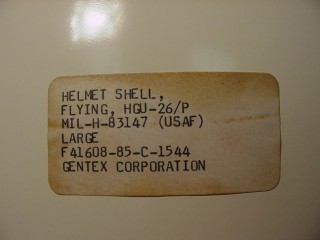
Message 1497:
I have noticed a trend on E-Bay and it may have something to do with the distribution of
US flight equipment. I am just thinking out loud and welcome any comments.
I would say that during the cold war, a substantial number of USAF aircraft may well
have been deployed in Europe. I noticed early on when dealing with European collectors
that they had quite an array of USAF flight gear, but were not as well stocked on US Navy
equipment. In fact, I made quite a few trades of Navy equipment for International
equipment. It would seem that the "demand" for US Navy equipment has created a
sort of conversion process for sellers on E-Bay. What was a USAF helmet can be cleaned up
and marketed as a US Navy helmet to fetch a higher price.
One of the things that is disturbing to me is the very high premium some collectors are
willing to pay for "decorated" helmets. Especially when the helmet has a nice
fresh coat of paint and shows no sign of wear. Coupled with the confusion over USAF vs US
Navy helmets, it would seem there are a lot of cross over items that are simply not
authentic. I am interested in hearing the opinions of others as regards to the paint
jobs and decorations that adorn some of these flight helmets and also would like to hear
from others on the US Navy Vs USAF helmets.
The USAF life support guys told me they didn't use Navy helmets AT ALL. Perhaps because
the helmets are all cut from about the same mold, literally. To put this in perspective:
The APH-5 and HGU-2 are the same helmet shell. The HGU-22/P is the same shell as the
HGU-2 which is the basis for the HGU-26/P.
This next part is probably going to get me in a jam, but here goes anyway. The USAF tried
to cut the HGU-22/P shell back at the 3, 9 and 12 o'clock position to increase visability.
It was discovered that these cuts waekened the shell .So the USAF jumped on the HGU-33/P
shell (PRK-37/P) for the HGU-48/P which was the basis for the HGU-55/P.
That means there are basically 2 helmet shells for most of the USAF/USN helmets and would
mean that cross use between services is unecessary. Even the APH-6 is the early
shell with o-mask cut outs.
For the record, I have a report on the HGU-48/P that verifies the use of the HGU-33/P
shell. This should also explain why the Navy could transition with little effort to the
HGU-55/P. Cause the -33 is a -55 with a visor assembly....
Now you may talk amongst yourselves. For the record, my parents were married. Cheers,
Steve N
Message 1430
Not a "tired" old subject at all. The APH-5 to HGU-2/P story is always
interesting. I'd love to hear more about the specific APPROACH citation you referenced.
Better still, if someone was able to obtain a copy and make it available to all of us, eh?
Perhaps the USN Aviation Museum in Pensacola could dig out a copy of that issue, if no one
has one handy? Cheers, DocBoink
Message 1429:
Greetings all I kind of hate to dredge up this old topic [Message 929], but I
have not been around. The APH-5 was actually introduced into the Navy in 1956, there is an
article in "Approach" magazine announcing the introduction for fighter aircraft
first. I copied the article so I will try to get the exact citation. Bill
Message 1324:
> My point is that we make more a fuss of it then
> the people who work with it.
> To qoute an other life support worker:" I just
> work here, I am totally not
> interested in details.....).
Not so in the USAF-- I have heard Life Support folks even use the "P", as in
"55/P". Rich
Message 1323:
The HGU-22/P is a quarter Shell assembly. Assigned 26 April 1968. The Mil-spec is
MIL-H-83147. The HGU-22/P consists of the helmet shell, styrene liner, chin and nape
strap. Quoting from the DD61 Request for Nomenclature prepared by Ivan Dille:
"The purpose for designating this item is to provide for future Air Force procurement
of aircrew protective helmets under the component concept rather than complete helmet
assemblies". Several ASD letters are mentioned as references. For the record, the
HGU-23/P was the first helmet using the HGU-22/P helmet assembly. Cheers, Steve N.
Message 1318:
Hi Rich and Steen,
> As the writer of the article, I need to say that is how I interpreted the sections
quoted in the
> T.O. No where in a T.O. do they mention "HGU-22/P"except as a quarter shell
assembly, but do refer
> to HGU-2A/P and HGU-26/P. Go figure.
As the shell reads 22/P and the 2A/P is the one with the single visor. I referred to the
helmet with single visor to 22/P this is not correct as you mentioned. The same helmet
with dual visor is the 26/P. And then there is the one with the Sierra dual visor assy (as
seen on the APH-6) name?
The Netherlands Airforce and Navy do not really refer to and give names to helmets. Even
so the story on the P series. They named them P-4, no matter what type of P.... I met a
life support worker from a Naval Airfield working on the HGU-47/P helmet and they just
refered to it as the "new helmet". The older one being the APH-6.
My point is that we make more a fuss of it then the people who work with it. To qoute an
other life support worker:" I just work here, I am totally not interested in
details.....).
I enclosed a scan of the first part of the TO which describes what you already said. Bye
Ron
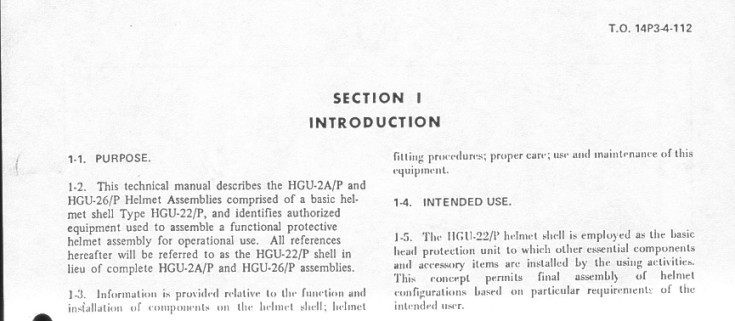
Message 1316:
As the writer of the article, I need to say that is how I interpreted the sections quoted
in the T.O. No where in a T.O. do they mention "HGU-22/P" except as a quarter
shell assembly, but do refer to HGU-2A/P and HGU-26/P. Go figure. Rich
Message 1309:
Hi Ron, Rich, and everyone else, Sorry to bring this up again, but I was surprised to read
about Dutch HGU-22 single visor helmets in the Going Dutch article on Flightgear-On-Line.
According to Rich's article on the Check Six website there is no such thing as an HGU-22
helmet. HGU-22 should refer to the shell alone. I am trying to get to grips with the
correct nomenclature of Danish helmets, and the HGU-22 joker pops up now and again.
Anything definite to be said on this? Cheers, Bluelight 14
Message 1287:
Hi Bluelight, [Message 1249] The addition of grey plush to the visor housing was
done in the Netherlands as well (see visor cover article). The custom fit liner is the two
piece molded example, these were covered with black leather. The edgeroll is the standard
Scott edgeroll assembly (one piece). This modification has been done in the Netherlands
also. And it is described as such in the TO's. So not so strange after all. Bye Ron
Message 1272:
Interesting, as I have an HGU-2/P with exactly the same metal reinforcing piece across the
visor cover, just below the knob slot. I wonder if this was a common modification, in view
of the fact that our two early HGU-2/P helmets, each from a different unit, both have
virtually identical mods. Cheers, DocBoink
Message 1253:
Hello Steve N. and all, I've attached images of an MBU-5 with the Christmas tree type O2
connectors per the query from yesterdays discussion. The coms should be clearly visible.
Hope this helps guys. Other things of note are the rivet reinforcement of the straps of
the mask ( at the cross over on the nose ),the repositioning of the mask receivers on the
shell, aluminum plate riveted to the front of the visor housing at the bottom of the slot
( it is not a repair, but just strengthening ) and on the rear view of the helmet, the
hand cut vents to the rear of the visor housing. This one has been around the block ! I
sure hope the images come through this time ! Steve Vallejo
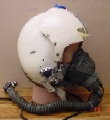
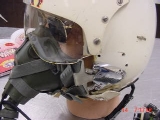
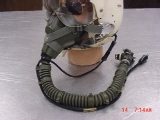
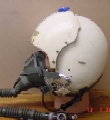
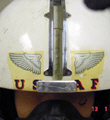
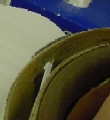
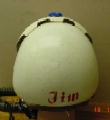
Message 1249:
Hi everybody, Let me contribute to the discussion on original or non-original helmet
configurations by posting these two photos of an HGU-26/P helmet. This helmet began its
life as a standard white HGU-26/P configured for fighter aircraft operations. First
modifications were the grey paint and the addition of grey plush to the visor housing. The
plush shows that the helmet was used by a Draken-pilot. The Draken cockpit is very cramped
as Zipper One will be able to testify, so we have always added a protective cover to
helmets used in Drakens to avoid scratching the canopy. Second modification was the custom
fit liner and the black leather edgeroll, and finally the helmet was modified for
helicopter operations by removing the oxygen mask receivers and adding an M-87/AIC
microphone, using one of the receiver holes. The communications cord looks like a standard
"Y"-cord as used on an MBU-5/P oxygen mask. This is no eBay hoax. All work was
carried out by certified technicians in Danish Air Force survival gear workshops. The
helmet is still property of the RDAF. Cheers, Bluelight 14
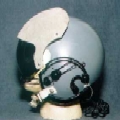
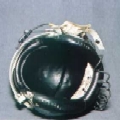
Message 1066:
Rich and others who weighed in on this: Thanks. I agree that it is most likely an HGU-26/P
with some gussying-up detail work. The earphone suspension string set-up did not escape
me--a system clearly never used by any Naval Aviator worth his salt (if you exclude the
hybrid APH-5A)! Cheers, DocBoink
Message 1051:
I am about 99% sure that the "mystery helmet" is a USAF HGU-26/P with a Sierra
snap-on edgeroll- note the earphone retainer string- something the USN never used. Looks
like a nice paint job, though. The only thing that isn't TO-proper USAF is the velcro
patch. Rich
Message 1015:
Hello Bluelight 14, Thanks for that mid-course correction. You are correct, of course. An
HGU-2A/P with a twin visor assembly by any other name (is not a rose?)...HGU-26/P
correctamente! Yes, probably a modified HGU-26/P. It will be interesting to see the
photographs you mentioned, if and when available. By the way, interesting information that
your aide identified the armored vehicle crew helmet immediately (on eBay). It certainly
looked like an awkward design and I do not recall seeing a chin-strap, either, although
surely there must have been one in actual operational usage. Cheers, DocBoink
Message 1009:
Hello DocBoink, Running the risk of being cheeky, according to Rich Mays' article on the
HGU-2A/P, -22/P and -26/P helmet (found on Flightgear On-Line) there is no such thing as
an HGU-22/P helmet (or is that still to be questioned?). To me the helmet looks like a
modified HGU-26/P. When I get my next film developed (alas, he has no digital camera...) I
will post a picture of an HGU-26/P modified with black leather edgeroll, M-87/AIC
microphone, plush-covered visor housing (to avoid scratches in the canopy) and holes where
the oxygen mask receivers used to be. Not an eBay hoax but an adaptation of a
not-any-more-first-line-use fighter helmet for helicopter use. Cheers, Bluelight 14
Message 1005:
Hello folks, Please see attached photographs (2) of a helmet whose identification type is
being sought. The only information available on it (from the owner) is that it 'appears'
to be of US Naval origin. The photos are not the best for revealing critical information
on this helmet, but it has the overall appearance of a US Air Force HGU-22/P that has
been 'messed with' a bit. The Velcro patch on visor shell right side would at first glance
suggest 'US Navy', but perhaps it has been placed there as a ruse or to mislead? Further,
the second photo reveals what appear to be the lower edge of an HGU-22/P type grey plastic
earphone cushion (left side). The chin strap appears to be standard USAF (HGU-22/P). The
helmet paint is a custom black finish and black-painted Sierra-type 02 mask receivers are
not slanted downwards (hence on angled "J" bayonet applications). Edge-roll
details are hard to make out but it looks different from standard USAF HGU-22/P beading
(add-on black leather edge-roll?). This would probably have been used
with "T" Sierra type bayonets, which is further support (in my opinion) that we
are looking at a USAF HGU-22/P with (as was pointed out amusingly by Rich Mays, in another
instance) an 'identity crisis'. Any other opinions on this matter are
solicited and would be greatly appreciated. Thank you. Cheers, DocBoink
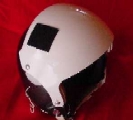
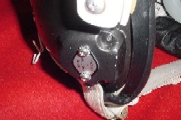
Message 929:
That confirms my long-held suspicions that it was a USN development that the USAF adopted.
This would also explain a few VERY early USAF HGU-2/P helmets that appear to be all but an
exact copy of the APH-5 except for the USAF star and wings (see one in particular that
appears in the Wise and Breuninger book--it also has a "stepped round visor
knob"). I am sure that before the USAF had standardized their own specific version of
the helmet, one or two Navy APH-5s were "worked up" as prototype HGU-2/P
helmets--hence the confusion over those oddball "early" HGU-2/Ps. Cheers,
DocBoink
Message 917:
Hi everyone. Though I'd share a couple of blurbs from a recently acquired technical report
from Gentex. Author of the document is one Aleander A. Kozuch and he is listed as the
manager of the model shop. The Report is titled 'Evolution of the Helmet ( P Series)
Shell". Of particular interest is the following lines, verbatum from the report: At
this time, a new helmet was being developed by the Navy and put into the system in the
early 1960s which Army Q.M and the Air Force adopted along with the Navy for their
aircraft. A track visor and housing assembly was also developed for the helmet. The Navy
called this an APH-5, the Air Force called it an HGU-2/P. This sort of cinches the common
roots of these helmets and may put to rest the "which came first" and
"which one is based on which" issues. Thought everyone would enjoy this. Cheers,
Steve N.
Message 828:
This is a quick return on an earlier response from Ron to my request for help locating an
original (1960-61) HGU-2/P edgeroll. The later rubber edgeroll material you mention as
being flammable and no longer allowed, which is the same grey slotted rubber edgeroll that
many of us have acquired in coiled lengths, was originally approved for addition to the
HGU-2A/P and HGU-22/P helmets. It is indeed flammable, and just for curiosity I took a
small section of it and held a match to it. It very quickly ignited, putting out a greasy
roiling flame and columns of noxious (probably toxic) smoke, that rose from the fire in
thick wreaths! Not hard, therefore, to see why it was banned from use on flight helmets
and is no longer allowed. This is very similar stuff to that which commercial airliner
seat cushions are equipped with and which still to this day some commercial carriers fly
with! Think about that next time you catch a flight from somewhere to somewhere else....
That stuff would be about as friendly to have around one's neck during a crash as a South
African burning tire. Yukko! Cheers, Chris
Message 709:
Chris--Who made your HGU-2? Consolidated, Gentex, or MSA? Each has slight differences in
strap and edgeroll color, and type of attaching screws. If you wish to replace the
twist-lock visor knob with the original pushbutton, one of our Canadian collectors can
maybe help you-- they used those longer than the US, and I have NEVER seen one offered in
this country. Also, do you wish to put this back into original configuration in every
detail, or retain the present oxygen mask retention system? Rich
Message 703:
Hi Ron, Thanks for the return on the HGU-2/P edgeroll matter. I have attached three photos
that may help identify the correct edgeroll. The first photo shows the WRONG grey rubber
edgeroll material, that was produced for retroactive application to the HGU-2A/P and
HGU-22/P helmets. It comes in a single, long length (whereas the HGU-2/P edgeroll is a
distinctively shaped and formed item intended only for use on the original HGU-2/P). The
second photo shows the area of one of the two front edges (left and right) of the helmet
in question, where the original edgeroll has either been cut away or worn away. The final
photo shows the helmet in a frontal view, that came with a date-congruent early MBU-5/P
mask (it is really quite nice except for the edgeroll sections that need refurbishment).
Cheers, Chris



Message 511:
I included a picture of the modified HGU-26/P I wrote about. In USAF T.O. 14P3-4-112 they
talk about a template to modify the edge of the helmet for better visibility, I could not
find evidence of this really have happened over here. Can anybody supply a scan of this
template as it is missing in my T.O. Ron
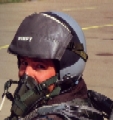
Message 508:
(USAF T.O. 14P3-4-112 explains how to modify an HGU-2A to HGU-55 configuration...) We did
the same in The Netherlands as well, I will upload a picture of one. Believe me, they look
like some sort of home made rubbish. They were fabricated from HGU-26/P's that were no
longer in use. Other 26's were modified in NBC helmets. Bye Ron
Message 338:
HGU-26/Ps are routinely offered on E-Bay with VTEC liners. There is no evidence that the
USAF ever used the VTEC liner in the HGU-26/P. In fact, the USAF has an earlier form fit
system that was in use before the VTEC liner was adopted by the Navy.In point of fact, the
USAF system was in use as early as 1956! Steven Norris
Message 331:
> but I am missing still some visorcovers for the PRU-36/P. Does anybody have two of
those? > Would like them with original USAF markings on it. Have enough to trade, Ron
There are no markings on any USAF gear (at least from the factory). The early version is
white plastic only, while the later version has silver aluminum reinforcing strips on each
edge where the mounting screws are to enable the attachment of EEU-2/P and -2A/P nuclear
flash visors. PRU-36/Ps destined for the HGU-55/P are sprayed gray; earlier ones are bare
white to match the HGU-22/P shell assemblies. Rich Mays
Message 238:
First, you need to determine if you have an early or late HGU-2A shell. If it has 3
cooling holes in the crown, it is early, and you will need a styrofoam liner with
corresponding holes. Further, if it has holes, you need an early visor housing, identified
with blue plastic surrounding the lock knob track in the same manner that the HGU-2 had
silver metal. The gullwing housing mod became official in the late 70s & 80s. There
were 3 styles of twist-lock knobs procured-- two in white, and one in blue. Rich Mays